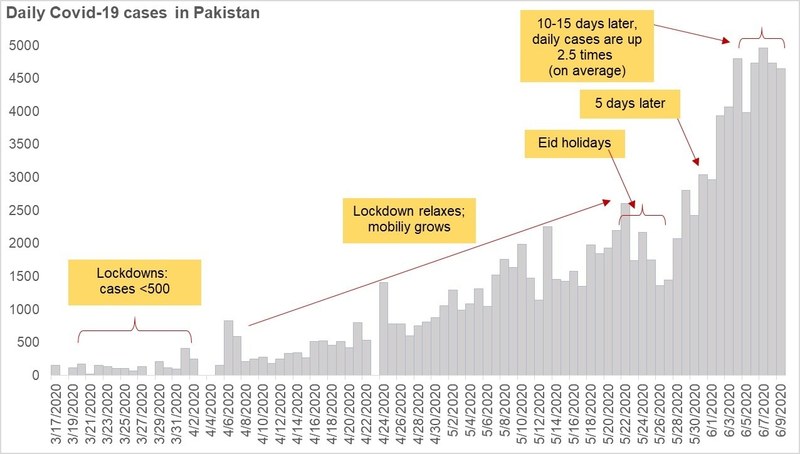There is a new dirty word in town, dirtier than Covid-19 itself. It’s called herd immunity. No country wants to own the word but several, it seems are now adopting this very strategy—Pakistan included. As new cases continue to climb and lockdowns are completely relaxed, warnings from local and foreign experts, including the World Health Organization (WHO) are resoundingly clear: Pakistan is very much in danger.
Evidently, Pakistan has decided to ride the coronavirus wave, instead of breaking it. But it is clear the wave is turning into a tsunami. Different simulations suggest that the current tumultuous journey with no-end-in-sight will have catastrophic effects—some foreseen and many unforeseen (a number of medical complications could materialize through infection that still remain unknown) on the population.
Associate Professor at IBA, Dr. Adnan Haider predicts based on existing covid-19 cases, infection rates as well as current death rate, Pakistan could be staring at nearly 1 million deaths. The latest Imperial College simulation suggests Pakistan could witness over 2 million deaths. There are caveats but these are disturbing numbers.
Evidence suggests that nearly 40 countries have adopted and enforced some form of lockdown and managed to flatten the curve. Several such as Japan and South Korea were able to beat the virus through massive preventive measures included mass testing, isolating, track and tracing measures, while spending on strengthening the healthcare systems.
Despite locking down for a while there, Pakistan has not been able to successfully implement lockdowns, and in fact, new cases have grown unabated as restrictions began to relax (read more: “Six feet from the edge”, June 11, 2020). Perhaps a complete lockdown was always going to be a problem given the high poverty level in the country and the already weakening economy but is herd immunity the solution?

Herd immunity essentially means that once enough people in a population (estimated 65% for covid-19) are infected with the virus, they will develop immunity against it. How does that work? Suppose 80 percent of the population was infected and became immune to the virus, this means four out of every five people will come into contact with someone with the disease, will not get sick and subsequently will not spread the virus any further. Obviously, this is risky because a majority of the population has to become infected for it to even work. Evidence suggests that Sweden, a country famously moving toward herd immunity had projected herd immunity to hit by now, but has not managed to attain it in the time. In fact, the major assumption here is that people with antibodies against the coronavirus are actually immune. There isn’t sufficient evidence to support that.
So what will work now? In a letter to the Punjab Heath Minister, the WHO warned that Pakistan did not meet any of the pre-requisite conditions for opening of the lockdown. The letter argues: “The positivity rate is 24 percent—above the required 5 percent level, the surveillance system (identify, test, isolate, care for all the ill including identification and follow up of contacts and quarantining is weak). There is limited capacity to provide critical care and population is not ready to adapt to change in behavior (hand-washing, respiratory etiquettes and social distancing”. The WHO went on to call for an intermittent state-mandated lockdown citing how new cases could be brought through a two-weeks on and two-weeks off strategy. The curve is the smallest with an intermittent lockdown scenario.
This has been earlier argued by the PIDE team in its bulletin (#17). The note argues that an intermittent lockdown could be the best strategy there is where the country will undergo 10 days of lockdown and four days of work every fortnight. This 4-10 day cycle would be easier to manage, and the public would be more inclined to adhere to the lockdown strategy as staying-at-home for long periods of time for a working population seems impossible.
Research suggests that the intermittent lockdown will reduce the virus replication number which is the number of people infected by one infectious person. This will ultimately reduce the total number of cases. The intermittent lockdown strategy will have to be combined with strict adherence to mask-wearing, maintaining 6-feet distance from everybody in public and washing hands for two minutes among other SOPs. Better state and provincial level mass communication through various mediums (mosque announcements, radio and other popular media addresses, telephonic messages etc.) will have to go hand in hand so the larger population begins to follow necessary precautionary measures.
There is mounting evidence that intermittent lockdowns do work and social distancing has enabled several economies to flatten the curve already, and in some cases, even managed to stop an outbreak. Given the precarious state of Pakistan’s crumbling healthcare delivery systems, herd immunity—though there is no evidence it even works—is a death sentence. Literally.























Comments
Comments are closed.